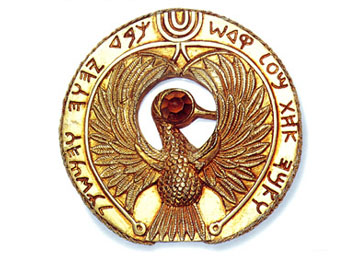
Fajada Butte ("banded butte") rises 380 feet above the valley floor to an elevation of 6623 feet in an almost perfect north-south, east-west axis. The butte stands in a prominent two-mile wide gap between the East Mesa and Chacra Mesa, which form the south wall of Chaco Canyon. The summit of the butte offers commanding views of Chaco canyon and of the vast expanses to the South, and as such makes a unique observation site, either for astronomical or surveillance purposes. The climb up the Butte is not easy. Without rock climbing hardware (or uncommonly good rock climbing skills), there is only one possible route up the Butte, with the crux located halfway up and consisting of a steep forty foot "chimney" cutting through rock of dubious quality (by rock climbing standards). Despite the difficulty of the climb and the lack of available water, ruins of approximately 20-30 dwellings are found along some of the higher cliff bands around the Butte.[1]
In recent years evidence has been uncovered that a large ramp had been built on the SW face of the butte, to facilitate its ascent. The ramp, 750 feet long and rising almost 330 feet above the valley floor, was apparently constructed in three sections. The first followed an erosional ridge to the first prominent cliff band on the butte. The second was a heavy masonry structure that extended from the top of the first cliff band to the second cliff band, along which ruins of numerous small cliff dwellings are to be found. The final part of the ramp was likely a combination of carved steps and scaffolding structures. Even by Chacoan standards, this represents a construction project of a significant magnitude, and suggests that the butte might have played an important ceremonial role at Chaco. The 3-slab so-called Sun Dagger site is located at the foot of the uppermost 40 foot high cliff band.
Photo courtesy SOLAR PHYSICS, NASA Marshall Space Flight Center
The three sandstone slabs are 2 to 3 meters high, 0.7 to 1 meter wide, and 20 to 50 centimeter thick. They are estimated to weigh around 2 metric tons (2000 kg). Geologic evidence indicates that the slabs were originally part of a single large block which broke off from the cliff face to the left of their present position and toppled over, fracturing along two weaker bedding planes upon impact. The three slabs do not touch, being separated from each other by narrow gaps about 10 centimeter wide. The solar marker nature of the site was discovered serendipitously in 1977 in the course of a survey of petroglyphs on the Butte.
The slabs rest almost vertically against the smooth cliff face, fanning out to the south. They form the side wall wall and roof an elongated triangular niche which remains shaded except around midday when sunlight shine through the openings between the slabs. The cliff wall is illuminated in this way for about 25 minutes near summer solstice, and up to three hours near winter solstice when the sun is lower in the sky. A large rock overhang situated above the site shades the slabs when the sun's elevation climbs to high as it does in the summer months.
Graphics courtesy Jere Confrey, University of Texas at Austin
Alan Maloney, Quest Multimedia Math and Science
Considerable controversy regarding the possible man-made nature of the 3-slab site developed following the first reports of its operation as a solar calendar. Further studies yielded several lines of evidence indicating that the site is the result of a natural rockfall, rather than an Anasazi construct. The Anasazi were not in the habit of using large stones for their constructions, except as foundation for the large roof posts of their great kivas. Even then, the slabs are some five times heavier than the heaviest such foundation stones unearthed in Chaco Canyon's great kivas. The Chacoans were clearly very adept at masonry work, and have been known to construct supporting walls to buttress large rocks perched in positions posing a threat to their dwelling, most notably behind Pueblo Bonito. Yet no sign of any such reinforcement work is to be found around the 3-slab site. It has also been noted that geological formation resembling the 3-slab site are common throughout the canyon, and examination of the base of the slab indicates that a piece of one of the slab broke on impact, arguing against the slabs being artificially positioned by human hands.
Dating Chaco's Lost Sun Dagger site has also proven problematic. Pottery fragments recovered from the small dwellings located near the site are of the Mesa Verde style. Occupation of the canyon by emigrants from the Mesa Verde area occurred mostly after the Chacoan towns were abandoned, with only little temporal overlap.
Copyright 1999, P. Charbonneau , O.R. White, and T.J. Bogdan
THE SPIRITUAL ELDER AND THE SANTA FE CHIEF
MAYA RUINS AND THE SPRING EQUINOX
TRAVELS IN THE YUCATAN
ASTEROIDS, SHAMANS, AND HIDDEN MAGIC OF MAYA TEMPLES
INCIDENT AT SUPAI
A SHAMANIC JOURNEY OUTSIDE THE TRADITION
YAMIL LU'UM
WE DO NOT HAVE SHAMANS
The Case Against "Shamans" In the
North American Indigenous Cultures
DID THE WANDERLING FLY?
(please click)
AS WELL AS:
THE METEOR CRATER METEORITE: WHAT HAPPENED TO IT?
ON THE CRATER FLOOR: Meteor Crater, Arizona

